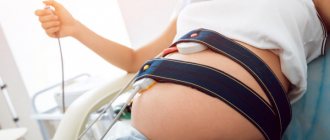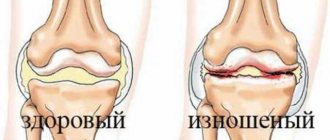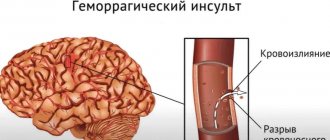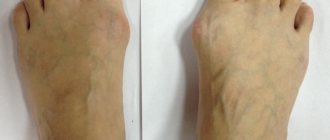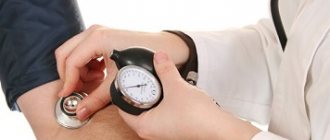Hemorrhoids are a vascular disease in which dilation of the hemorrhoidal veins of the rectum is observed, causing the formation of characteristic hemorrhoids that cause pain and bleeding in patients.
Diagnosis of hemorrhoids is not difficult: more than 90% of cases are determined during a digital examination of the anus and do not require the use of instrumental research methods.
Causes
The root cause of hemorrhoids is a violation of the inflow and outflow of blood in the cavernous bodies of the rectum. Normally, the corpora cavernosa (also called cavernous bodies) help control the urge to defecate: when filled with blood, they “swell” and help retain feces in the intestines, and after a successful bowel movement, blood flows out and the corpora cavernosa shrink.
If the inflow/outflow regulation is disrupted and the corpora cavernosa have been engorged with blood for a long time, this causes the vascular walls to dilate and thin, making them much more susceptible to rupture or erosive lesions, which in turn cause inflammation and can lead to blood clots.
Factors that provoke venous stagnation
The following predisposing factors can provoke long-term venous congestion in the corpora cavernosa:
- Physical inactivity.
A low level of physical activity (due to sedentary work or simple laziness) causes extensive disturbances of venous blood flow throughout the body - and in the rectum in particular.
- High loads.
Ultra-high physical activity associated with lifting weights causes excessive tension in the abdominal muscles and rectal area, which also leads to disturbances in the venous blood flow.
- Chronic constipation.
The presence of feces in the rectum causes a constant, permanent filling of the cavernous bodies with blood, as mentioned above.
- Venous pathologies.
Impaired blood flow in hemorrhoidal veins can be caused by various vascular diseases.
- Oncology.
Tumor formations in the rectum cause disturbances in the inflow/outflow of blood due to mechanical compression of the venous vessels or their deformation due to tumor growth (in later stages).
- Diarrhea.
Severe diarrhea, especially caused by poisoning or infectious diseases, causes congestion of the venous system of the rectum, which leads to dilation of blood vessels or even micro-ruptures, followed by an inflammatory process.
- Pregnancy and childbirth.
Bearing and giving birth to a child is often accompanied by multiple disturbances in the pelvic venous circulation system, which can (but not necessarily) lead to the appearance of hemorrhoids.
- Obesity.
The presence of excess weight, by analogy with physical inactivity, also leads to multiple disturbances of venous blood flow.
- Bad habits.
Chronic alcohol abuse or long-term tobacco smoking provokes varicose veins, which primarily affects the pelvic region and lower extremities.
- Heredity.
Low hereditary elasticity of the venous vessels of the rectal area creates a predisposition to hemorrhoidal disorders - although it is not considered as their direct cause.
Diagnostics
For diagnosis, the patient visits a proctologist. The private proctology clinic uses modern treatment methods and new equipment. The proctologist receives information about the patient’s medical history, studies the medical history and data from diagnostic studies. Digital examination, anoscopy and sigmoidoscopy are performed. An examination of the rectum is carried out on a gynecological chair. The patient bends his knees. A medical specialist examines external and internal hemorrhoids, examines the condition of soft tissues, feces and mucous secretions.
Anoscopy allows you to determine the location, size and condition of internal hemorrhoids. For a rectal examination, the patient should push to ensure that the information is more accurate. If there is a suspicion of damage to parts of the large intestine, irrigoscopy and colonoscopy are prescribed. During the examination, the doctor excludes or confirms the presence of concomitant diseases of the esophagus, rectum, and anus. First of all, the presence of malignant neoplasms should be excluded.
Symptoms
The main signs of hemorrhoids are bleeding from the anus, as well as pain, itching and discomfort in the rectal area. The severity of symptoms differs depending on the form of the disease (acute or chronic), as well as its stage (neglect).
Signs of chronic hemorrhoids
The nature of the symptoms is determined by the stage of the disease:
- Stage 1.
As a rule, there are no disturbing signs, and the presence of hemorrhoids can only be detected with targeted research. In rare cases, patients complain of occasional pain and itching in the anus or minor traces of blood on toilet paper.
- Stage 2.
Visually visible and easily palpable hemorrhoids appear, which still retain a certain “elasticity” and therefore do not fall out of the rectum. Bleeding, pain, itching and discomfort in the rectal area do not always bother patients; sometimes the disease is still asymptomatic.
- Stage 3.
Hemorrhoids protrude and often bleed. Pain and itching become constant, intensifying with bowel movements or physical activity. Thrombosis of hemorrhoidal veins may occur.
- Stage 4.
Hemorrhoids become large, constantly hurt and bleed. Primary signs of tissue necrosis may also be observed.
Symptoms of acute hemorrhoids
The acute form of hemorrhoids occurs against the background of complete or relative well-being, when there were no hemorrhoidal formations at all or if the disease was asymptomatic. The transition to the acute stage is accompanied by the following symptoms:
- sudden sharp pain, most often occurring during bowel movements;
- heavy bleeding as a result of rupture of a venous vessel;
- severe itching and discomfort that does not disappear even after completion of the bowel movement;
- the appearance of visible and severely inflamed hemorrhoids - if these have not been observed before.
Chronic combined hemorrhoids - treatment
Depending on the severity of the pathology, the proctologist determines the treatment tactics. With grades 1 and 2 of hemorrhoidal development, conservative therapy with medications is possible. More severe pathology requires radical therapy. The hospital's first surgical department uses various surgical techniques. Surgery for combined hemorrhoids is preferable, which is performed using gentle techniques to achieve minimal trauma to healthy tissue.
Disease prevention
Even in the absence of symptoms, it is extremely important to follow preventive measures to avoid the appearance of hemorrhoidal cones and an increase in their size. To do this, you should visit a proctologist every six months for diagnostic tests. At home, it is recommended to do baths and microenemas, and use rectal suppositories, which have a positive effect on the microflora and the condition of soft tissues. In a hospital setting, cauterization of blood vessels is performed.
It is important to follow a diet, include fermented milk products, fruits and vegetables in your diet, and drink plenty of clean water. To improve the functioning of the esophagus, avoid excessive consumption of caffeine and alcoholic beverages. Spicy seasonings and sauces irritate the intestinal mucosa.
Every day you need to walk in the fresh air and do physical exercise. This prevention is especially important for people who lead a sedentary lifestyle. Squats will help relax your muscles and improve blood flow in your veins and arteries.
Proctologists advise limiting heavy lifting and excessive physical activity. Try to minimize muscle tension. To activate blood circulation in the anus and avoid enlargement of hemorrhoids, you can rinse the anus with cool water using herbal remedies.
To avoid irritating the soft tissue of the anus, you should purchase damp toilet paper. Only with a timely visit to a proctologist can complications and the development of proctological diseases be avoided. To make an appointment, call the number listed on the official website. An employee of the private medical clinic “Proctologist 81” will call you back and confirm the selected time. Prices for diagnostic tests and procedures are posted on the website. The cost depends on the stage of the disease and the presence of concomitant pathologies.
Treatment methods
The following methods are used in the treatment of hemorrhoids:
| Hemorrhoid stage | Treatment |
| First | Creams, gels, rectal suppositories, drugs, sclerotherapy, photocoagulation, Bicap diathermocoagulation |
| Second | Hardening of nodes, medications, photocoagulation, latex ring ligation, thermal probe, Ultroid current |
| Third | Drug therapy, latex ring ligation, Ultroid current, hemorrhoidectomy |
| Fourth | Hemorrhoidectomy, phlebotropic drugs |
In the early stages of hemorrhoids, traditional medicine using herbs, decoctions and mixtures is also used.
Hemorrhoids 4 degrees
The patient's condition is rapidly deteriorating. Stage 4 hemorrhoids require immediate surgical intervention and removal of hemorrhoids. The advanced disease is characterized by pain when walking and even while sitting. Reduction of tumors into the anus is impossible.
Bleeding becomes profuse. As a result, anemia or anemia is diagnosed. The patient feels severe weakness, loss of strength, and lack of appetite. Blood clots form in the cavernous veins, which negatively affect the blood circulation process. Hemorrhoids become inflamed, thereby provoking the appearance of suppuration and necrosis, dead areas of soft tissue. Harmful bacteria spread throughout the body and worsen the condition.
Hemorrhoids 2nd degree
This stage is accompanied by pain during defecation. Exertion and physical stress also occur with discomfort. Bloody discharge from the anus appears on the underwear. The patient notices bloody clots even in the absence of bowel movements and in a calm state. After a bowel movement, you feel like you have an empty bowel.
Stage 2 hemorrhoids require special attention and urgent treatment. If the patient misses time, then conservative treatment will not help cure the disease in the future. The proctologist prescribes hemostatic drugs and rectal suppositories. Minimally invasive treatment methods are carried out, including sclerotherapy using special injections. The injection is injected into the base of the blood clot and promotes its death.
Infrared coagulation is also performed. Accompanied by cauterization of hemorrhoids using laser radiation. In case of complications, the patient is referred for latex ligation. The blood vessels of the anus are compressed with a latex ring, after which the pathological neoplasm dies and disappears. There is no blood flow, so the node comes out of the anus.
Traditional medicine is also effective in this case. The patient is given microenemas of rosehip or sea buckthorn oil. The doctor prescribes baths with a decoction of chamomile, oak bark, birch, and potassium permanganate. A special anti-hemorrhoidal collection is also used.
Prevention of acute external hemorrhoids
- timely treatment of the initial stages of hemorrhoids and minimally invasive treatment;
- maintaining a healthy lifestyle with the introduction of a rational diet, physical activity, and absence of sedentary work;
- elimination of chronic constipation (nutrition, drinking regime);
- compliance with the principles of personal and intimate hygiene;
- visiting a specialized specialist, conducting diagnostics when the first symptoms of hemorrhoids appear;
There are contraindications - specialist consultation is required!

